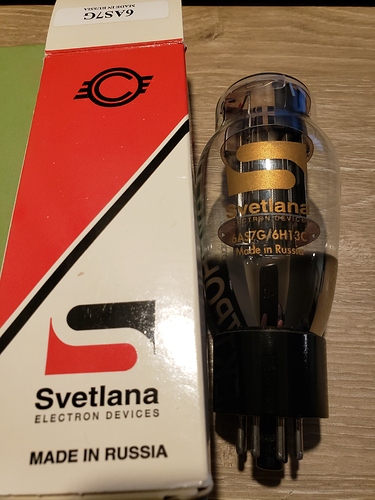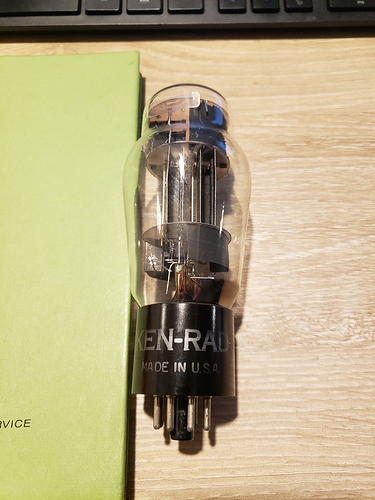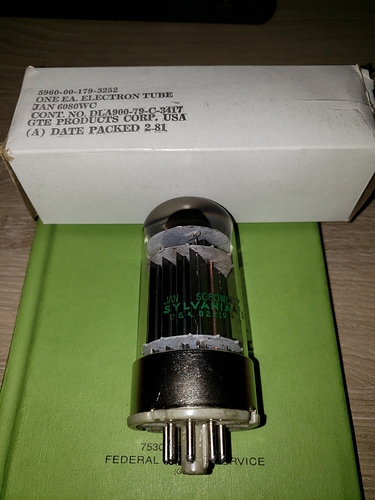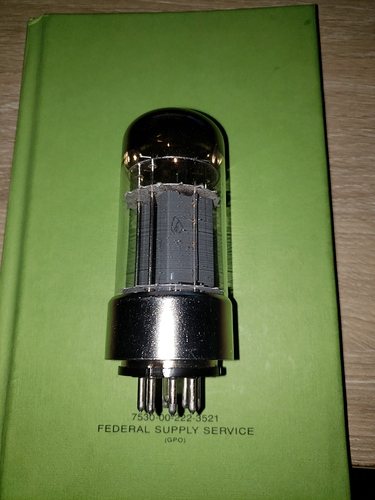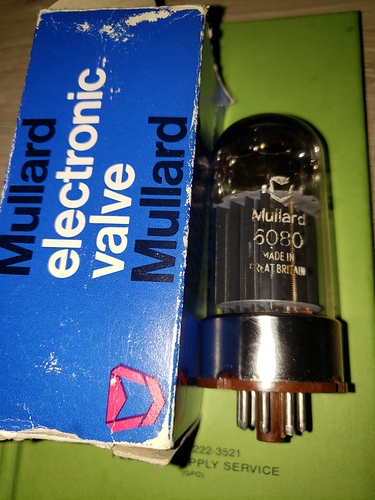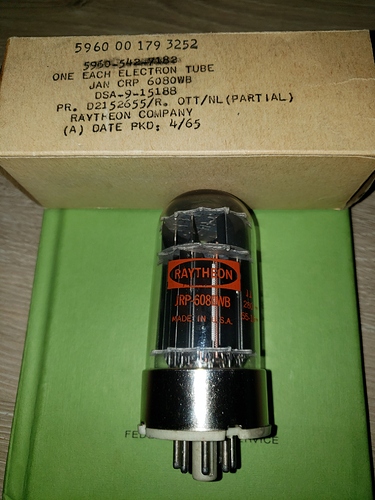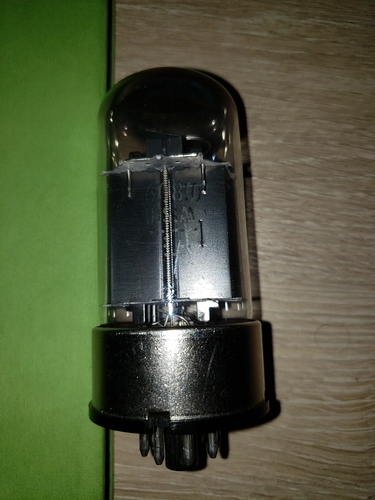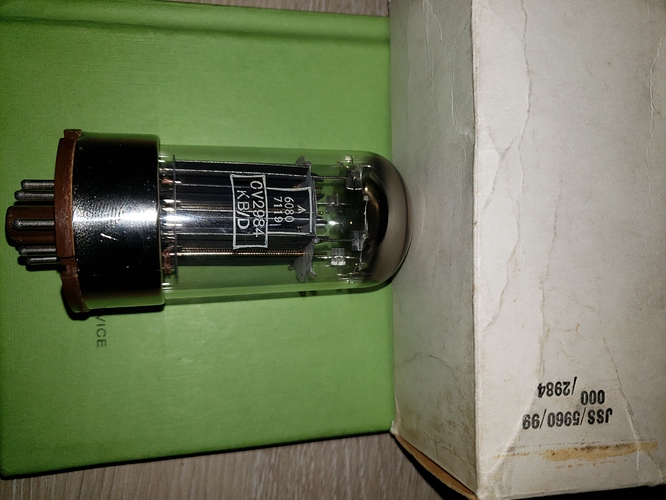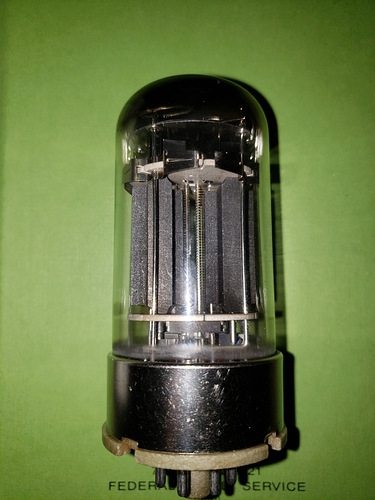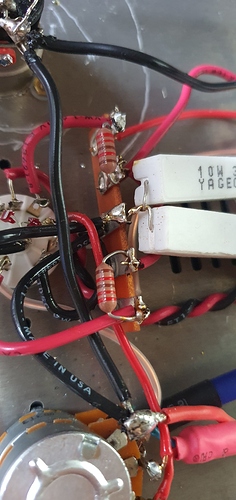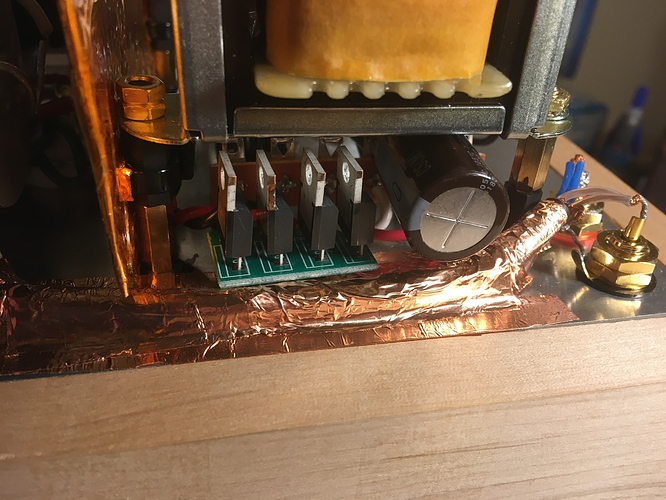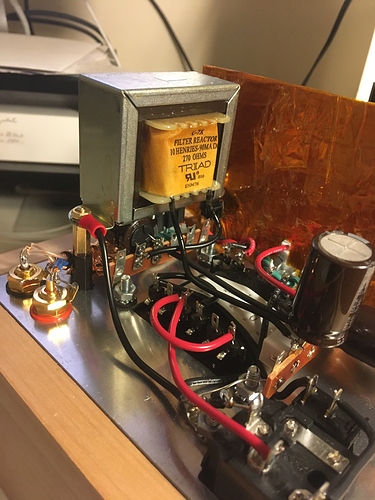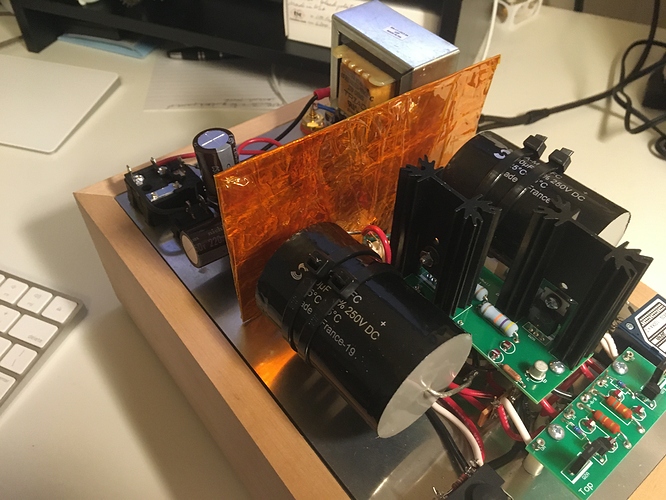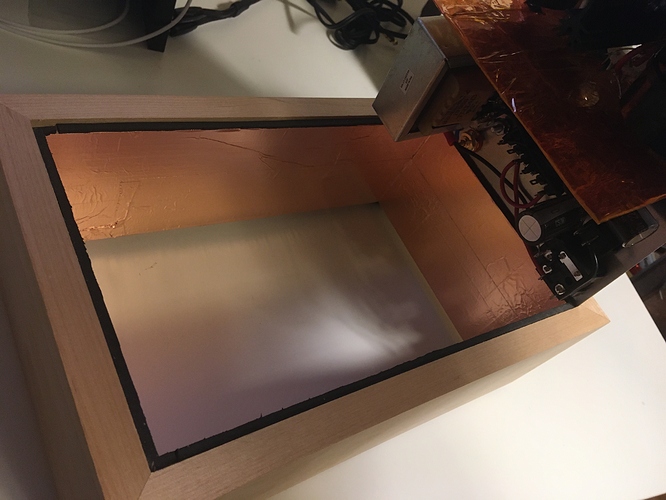Did they give you a build manual? If not, message me and I’ll send you a copy of mine.
i have the manual, but thank you a lot for that offer! The only thing that seems missing is the numbering of the Terminal, but ive found that on the Internet.
So for power tubes on the BHC, you can use a 6080, 6AS7, 7236, 5998, 421a, 6N13S, 6H13C. I own a few of these tubes, so I wanted to share my impressions.
Soviet Era Svetlana “Winged C” 6H13C Tube
This is a decent tube considering it is much lower in price to it’s counterpart U.S. Made 6AS7G tubes. These are easily identifiable by the Soviet factory stamped marking “OTK” on the glass somewhere. These are referred to as the winged C based on the logo (seen on the top red portion of the box). These tubes have a nice soundstage (not too big, not too narrow). These tubes present the bass in an authoritative manner, but sadly it is sort of a “one note” midbass thump. The mids sound like they get lost somewhere in the upper regions right before the transition into the treble. The treble on this tube is extended, but very grainy and it has some glare. Still, for $13 this is a good price to performance option for many.
Ken-Rad 6AS7G Tube
So the long and short of it is that RCA, Sylvania, and GE manufactured the majority of 6AS7G tubes. The harder to find Tung-Sol or Chatham (purchased by Tung-Sol) 6AS7G or even the rarer 5998 tubes are the only ones that sound different. These have a wide soundatage and a very inoffensive and linear sound. Another good price to performance option. In my experience, these do have a tendency to be microphonic.
GE 6AS7G Tube
See the above.
Sylvania 6080WC Tube
These are a more rugged militarized 6080. They don’t really stand out much. This tube is way more forward and aggressive sounding than the stock GE 6080. The bass isn’t so good and the mids and treble are way too aggressive and have glare that is easily distracting to the rest of the sound signature frequencies.
Tung-Sol 7236 Tube
This is another aggressive sounding tube. It has a higher gain than 6080, 6AS7G or 6H13C tubes. The soundstage is sort of claustrophobic and narrow. The tonality sounds right though, at least in the bass and mids. The treble is very airy, but can become overly forward when paired with the wrong preamp tubes. With the right preamp tube however, the 7236 can provide an endless amount of detail, energy, and fun.
Mullard 6080 Tube
This is an excellent 6080, one of the best you can get. Bass is just right and has nice layering and detail. The mids…superb. I don’t think any tubes that I’ve heard other than the Bendix 6080WB even come close. Mids are detailed, but not overly so. They transition into the treble with ease. The treble is very slightly subdued, but still tonally correct to my ears. There is a tiny bit of air at the top end that kind of holds the treble together. Full disclosure…I’m a bit of a Mullard fanboy, lol.
Raytheon 6080WB Tube
This is a nice and affordable upgrade to the stock GE 6080. It has more slam in the bass, but it can get overly thick when paired with the wrong preamp tube. It has a upper bass lower mid forward sounding signature. The treble is sort of subdued and takes a step back on this tube…but I feel it is better sounding than the treble on the stock GE 6080.
GE 6080 Tube (stock BHC tube)
If you own a BHC, chances are this tube is what came stock. It is the textbook definition of “a jack of all trades, but master of none”. But, it is very clean and natural sounding. It also has the lowest microphonics of any of my power tubes.
Mullard CV2984 Tube
This is the British Military version of the Mullard 6080. The main difference is that this tube should hypothetically last much longer than the Mullard 6080. They sound remarkably similar. The differences being that this CV2984 seems to have a more punchy bass and wider soundstage.
Bendix 6080WB Tube
I don’t even know where to start with this tube? It slightly beats out my Mullard CV2984 as my favorite power tube. Bendix made these tubes for the U.S. Navy, specifically for Nuclear related tasks and for highly sensitive communication related tasks. The tube is much heavier than other 6080 tubes. This is because it has dense graphite plates (only 6080 with graphite plates) and additional support rods and clips. The sound is very linear and balanced. The bass is the fullest sounding of all the power tubes I’ve heard. Truly breathtaking to hear such tonally correct and detailed bass from a tube. The transition into the mids is effortless and the mids have a velvety character to them.. very pleasing. The transition into the treble is again very effortless. The treble is very balanced between smooth, yet detailed. There may be the tiniest bit less air up top, but that is because the rest of the treble range beneath it is remarkably full with no grain or glare. Word to the wise though…these tubes do not come cheap. They usually range from $175 to above $1,000.
Hazi this is awesome man. Not too many (if any) specific guides like this on the web. At least that I’ve come across. Thanks for sharing the knowledge 
I appreciate the compliment. There is a lot of tube history and knowledge out there…the problem is that it is hard to find an accurate and trustworthy source of information…especially on some of the rarer harder to find tubes.
I also only gave short and condensed bulletpointed impressions, but there is a lot more I didn’t cover.
If anybody has any questions or wishes for me to further clarify any of my statements from the post, please feel free to ask away. I’m definitely here to help. 
This thread packs a lot more information than some of the other longer ones I’ve read.
I have a lot of nice upgrade pieces, but those power tubes are ridiculously hard to find, and cost big for the best ones… I’ve got my Amperex EC80CC (yes I changed the resistor), Clarity Cap MR 100 ohm, Mundorpf, Auricap XO, etc.
I’ve rebuilt and built a number of crossovers, and just like with tweeters in speakers - really good caps in the signal path can drive the unit beyond expectations quality wise.
So after hours of soldering and troubleshooting i think i have found the issue. I just switched the small resistors shown in the picture left to right and the crackling went from left channel to the right channel.
With the help of @MazeFrame ![]() , i have ordered parts and will be able to fix it i guess. I will change the silver caps in my build to some similar inthe original build and will replace a few wires aswell.
, i have ordered parts and will be able to fix it i guess. I will change the silver caps in my build to some similar inthe original build and will replace a few wires aswell.
i hope the new resistors will fix it, but i guess they will!
Nice! Sounds like the resistor went kaput. Easy fix.
Resistor gone bad. Who would have guessed?
Then again, they are thin-films (according to the parts list you sent) and wedged between a tube socket and a pair of 10W resistors, so maybe they got cooked.
Could too much heat while soldering damage them aswell? The previous owner said, sometimes the crack has made these noises, but it sounded more like it made these sounds since ever and for that reason he was selling it…Just wondering…
In theory, yes.
With the size (= power rating) of these though, you would have the legs off before the internals overheat.
My concern would be what killed it, I’ve only ever seen them fail when they act like fuses.
Maybe the builder screwed up at some point and managed to kill it, who knows.
Could either by user error like you suspect or QC fail.
Only way to tell what is wrong would be to hook them to an LCR-Meter, given the cost of those, not worth it.
Working on fixing solder jobs on guitars and you will see all the things a bad operator can cook. Alligator clips are your heatsinking friends and realise pots can hold a lot of heat for a considerable amount of time.
It’s not hard to cook a resistor if your soldering technique is shitty.
I got the bug to do something so I did a few mods. Replaced the rectifier bridge diodes with Schottky Cree diodes and replaced the first PSU filter resistor with a choke. Ended up with a bunch of hum in the left channel due to the choke magnetic field bleeding into the left output cap. Boo. Pulled out some copper tape and made a shield between the psu and audio section and all is good. And then because I’m anal, I lined the inside of the enclosure with copper. I’m sure there is no need for that but what the hell. Still need to replace the second PSU filter resistor with a choke. And then I’ll call it maxed out and stop messing with it…well…maybe a stepped pot lol.
Damn, that looks sick!
That’s the BHC i want when you are completely done, bored and ready to move on to your next project. I call dibbs now 


I love this thing, doubt I’d ever sell it. But if I go bankrupt, I’ll keep you in mind lol.
A little feedback on the mods I did over the last couple of days in case anyone is thinking of doing them. The amp sounds way better than it ever did. The highs are extended like never before, there’s way more depth, detail is better and, for the first time it’s dead quiet. I’ve had a lot of problems with noise issues and even sent it back to Bottlehead once for a look-over. Their response: zero problems, sounds a bit better than the few they had on hand at the time. Conclusion: my electricity is crap. I’ve tried all sorts of things like ground lifters, power filters, noise suppressors etc. I don’t know which of my changes did the trick or if it’s a combo but obviously the power supply is super clean now. It’s always sounded really good but it had these little noise annoyances.
